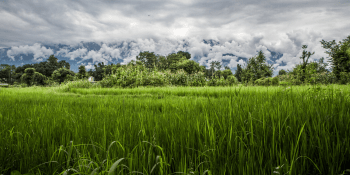National Adaptation Plans in agriculture: a work in progress

If conventional farming practices remain unchanged it could result in agricultural yield decreases of 10-15% globally in the face of climate change. Experts agree that the world is already committed to a 2°C mean temperature increase, but what happens if the climate changes more dramatically than our modest estimates suggest? The need for planned agricultural adaptation to climate change is unmistakable.
While there are a host of policy planning frameworks available to developing countries, the United Nations Framework Convention on Climate Change (UNFCCC) has provided guidance to Least Developed Countries (LDC) in the form of National Adaptation Programmes of Action (NAPA) since 2001. Building on lessons learned from the NAPA process (which focuses on ‘urgent and immediate adaptation actions’), guidelines for the development of National Adaptation Plans (NAP) have been created.
NAPs are designed to address medium and long-term adaptation needs. They encourage mainstreaming of adaptation with development objectives, and are intended to be iterative in nature, revisiting adaptation priorities and objectives at regular intervals.
In late February of this year the LDC Expert Group (LEG) - which provides technical guidance to LDCs in undertaking the NAP process - LDC representatives, and collaborating organizations met in Dar es Salaam, Tanzania to ‘simulate’ a NAP process, identifying key technical considerations for practical application of the guidelines in various sectors.
CCAFS has experience with the integration of agriculture in to NAPs. At COP19 in November of last year, CCAFS hosted a two-day learning workshop with both LDC and non-LDC countries to discuss the challenges and opportunities for agriculture within the NAP process. The results of the workshop were fed in to a side event on the same topic. The COP19 efforts also followed on successes in integrating agriculture in to Kenya's National Climate Change Action Plan.
In Dar es Salaam, CCAFS chaired the agriculture and fisheries working group at the LEG meeting. Experts from Tanzania, Togo, Rwanda, the Netherlands, Belgium, and the United States worked together to develop a ‘roadmap’ for vulnerability and adaptation assessment (V&A) in that sector. Strategies for stocktaking of existing agricultural policies and institutional structures were discussed, as well as data needs and tools for analyzing vulnerabilities and identifying adaptation responses. CCAFS climate data portal, analogues tool, and socio-economic scenarios were identified as key resources for various stages of V&A.
A few key ‘themes’ emerged during the course of the technical meeting that are worth commenting on:
First off, planning for the medium and long term requires different (and perhaps more) data than planning for the short term. A recent CCAFS publication, “Planning climate adaptation in agriculture”, for example, acknowledges this to be a key limitation in NAP development, citing the need to strengthen capacity to project risks, and prioritize response activities in many LDCs for NAP development. While NAPAs can assess existing vulnerabilities and identify adaptation options that can be applied today, NAPs require a better understanding of emerging trends, and future risks. There is simply more uncertainty. The agricultural and fisheries working group discussed the importance of both short-term variability and long-term progressive climate change. They reminded workshop participants that NAPs - if promoted alone - could draw focus (and funding) away from short-term needs in favor of long-term objectives when, in fact, both are needed in equal measure, particularly for the agricultural sector.
Secondly, in addition to technical support associated with the heightened data requirements of NAPs, there is clear need for more predictable and consistent funding sources for NAP development. This has been a major limitation in NAPA implementation.
As one LDC representative present at the LEG meeting suggested: it may take five years to finish our NAP if we don’t get funding!”
The NAP process is iterative, relying on the completion of early steps to inform later steps. When one process is halted because of the unavailability of funds, key inputs required for moving forward can be lost. Meeting participants acknowledged the need for better integration of Ministry of Finance and economic planning agents in the NAP development process so that financial needs are clearly relayed to relevant decision makers.
Finally, alignment of NAP objectives with existing development priorities was the subject of much discussion at the meeting. “What we learned from [NAPAs] is that what matters is not the list of projects, but how these responses can be better integrated in to national priorities”, stated one LDC representative. Given the increased data and funding requirements, NAPs are less vulnerable to political-economic ‘variability’ when they are strategically aligned with a country’s development vision and not viewed as a parallel processes. ‘Integration’ in to development planning processes also facilitates the revisiting of the NAP at regular intervals through established medium term planning protocols.
While the NAP process is in its early stages, success stories and lessons learned are already coming in. LEG meeting host country Tanzania, for example, is playing a strong leadership role having developed draft NAPs in several sectors, identified a NAP budget, established adaptation integration guidelines for national planners, and adopted a common monitoring and evaluation framework for climate change plans, programmes and projects throughout the country.
As other countries take on NAP development, they'll have much to learn from early adopters like Tanzania.
Visit the offical LEG Technical Worskhop website
Read more on Tanzania’s leadership role in climate smart agriculture
Chase Sova is a visiting researcher at the International Center for Tropical Agriculture (CIAT), a member of the CGIAR Research Program on Climate Change, Agriculture and Food Security (CCAFS), and a doctoral candidate at the University of Oxford, Environmental Change Institute (ECI). He works with CCAFS Theme 1: Adaptation to Progressive Climate Change.




